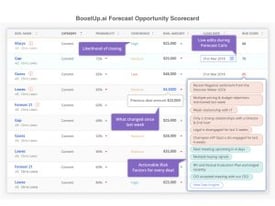The Revenue Blog /
How Are Top Sales Leaders Forecasting In H2 2019?
How Are Top Sales Leaders Forecasting In H2 2019?

Topics covered in this article
After Siebel promised the CFO that “our software will tell you if you are going to make your number or not” more than 39 years ago, 79% of the companies still miss their forecast by more than 10%.
So Siebel’s promise remains largely unfulfilled in 2019.
Forecasting technology & methods have largely gone through 3 phases of evolution –
1. The CRM Era of the 1980s to 2011: This was the period of using CRM data or spreadsheet data to forecast. The obvious problem here is that the CRM data is never filled on time and is biased from the seller’s judgment. While companies got smarter at forecasting accuracy by using historical data and correcting seller biases via manager overrides, CRMs have largely remained just databases holding manual inputs from sellers.
2. The Activity Era of 2011 to 2018: After Outlook opened their APIs in 2010, few companies came to the scene to create predictability by mining activity metadata from emails — things like, is the prospect responding over email (a.k.a the deal has momentum) or if the next meeting is even scheduled. These are useful indicators, but we also know that activity-based prediction is quite easy to dodge and intentionally misrepresent. OOO email from the prospect, or an email that says “I am no longer interested” while actually a negative thing could be misconstrued as a positive signal.
3. The Sentiment Era — 2019 onwards: We are now entering the era of using buyer sentiment in emails, calls, and speech to get an objective view of the deal progress and forecast accordingly. Buyer sentiment in its essence is about how the prospect feels about the purchase at different moments, their true interest and the likelihood of making a positive decision.
“While sellers could be precisely doing what they need to do, but to really know the sentiment of the buyer, you need a 360-degree view of the opportunity, and if you don’t have the buyer’s perspective, you may not have the right insight you need.”
– Michael Williams, Sales Leader and Co-Founder of Silicon Valley, VP Sales Forum
For the longest time capturing the volume of data to compute buyer sentiment across all communication channels was an impossible task. Now with modern APIs and accessibility of artificial intelligence, this is finally possible.
Best sales leaders understand that a forecast done accurately has the ability to spot potential issues and mitigate them before it is too late.
Those leaders have leapfrogged to The Sentiment Era of forecasting.
Many such leaders are using BoostUp.ai to improve their forecasting accuracy & comprehensively reviewing forecasted deals on multiple dimensions of risk —
1. Sentiment risk: objections from key stakeholders in late stages
2. Relationship risk: Single-threaded, weak relationships with key buyer roles
3. Dis-engagement risk: Senior titles or relevant buyer personas not engaging substantively over email and meetings
4. Out of sales process risk: Key topics not discussed, key actions not completed on time
BoostUp.ai automatically captures & summarizes these digital markers of forecast risk and surfaces early warning signs so you can act on them before it’s too late.

To quote a Sales Operations Director, supporting a 100 member revenue team —
“BoostUp.ai provided me a good x-ray into our pipeline and within minutes I had a 95% understanding of any deal even without prior context.
Our Sales VP and RVPs have a really good lens to evaluate deal risks without deep team conversations. My Ops team can use the relevant risk markers and intelligent algorithms to automate our forecast from the current manual rote process.
Overall, the ability to get a great overview of deal risks within minutes is compelling and probably the biggest surprise I experienced with BoostUp.ai.”
BoostUp.ai can help you too. Request a demo at demo@boostup.ai.



-Photoroom.png)